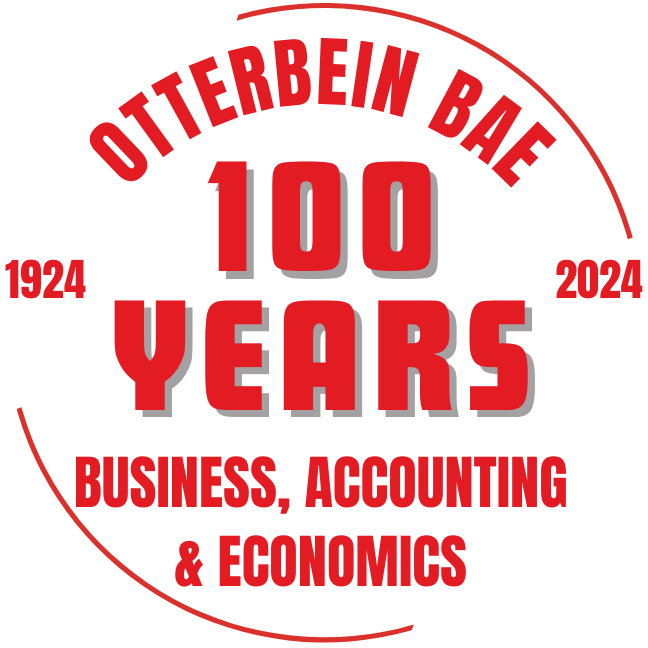
Join us to celebrate 100 Years of
Integrity and Excellence in Business Education!
Saturday, October 26, 2024
11:00 a.m. – 1:00 p.m.
Cowan Hall | Roush Hall
Celebrating 100 Years
The Evolution of the Department of Business, Accounting, & Economics
As one of the largest departments at Otterbein University, the Department of Business, Accounting, & Economics (BAE) has a rich history that spans over a century. From its humble beginnings to its current prominence, the department has played a pivotal role in shaping the educational landscape.
Notably, the first mention of a business-related department was in 1864, but it wasn’t until 1924 that the Department of Business Administration was established, initially focusing on business fundamentals. Since 1930, the department has undergone a significant evolution with a greater emphasis on economics. Professor Horace W. Troop, who served as chair from 1924 to 1952, played a crucial role in the department’s development. Under his leadership, in 1938, the department’s name was changed to the Department of Economics and Business Administration, reflecting its expanded scope.
The department integrated with business education for ten years (1952-1961) and was renamed the Department of Economics, Business Administration, and Business Education. In 1961, under the leadership of Dr. Bert Glaze, the department became a pioneer among liberal arts colleges by revising its curriculum to include more mathematics. A statistics laboratory was established in 1965. In 1990, Dr. Young Koo and Dr. Gerald Brown led the department to be renamed the Department of Business, Accounting & Economics, commonly referred to as BAE today. Over the years, the curriculum has continued to evolve to meet the demands of an ever-changing business world, expanding across disciplines such as accounting, business administration & management, business analytics, economics, finance, and marketing.
100 YEARS OF CHAIRS
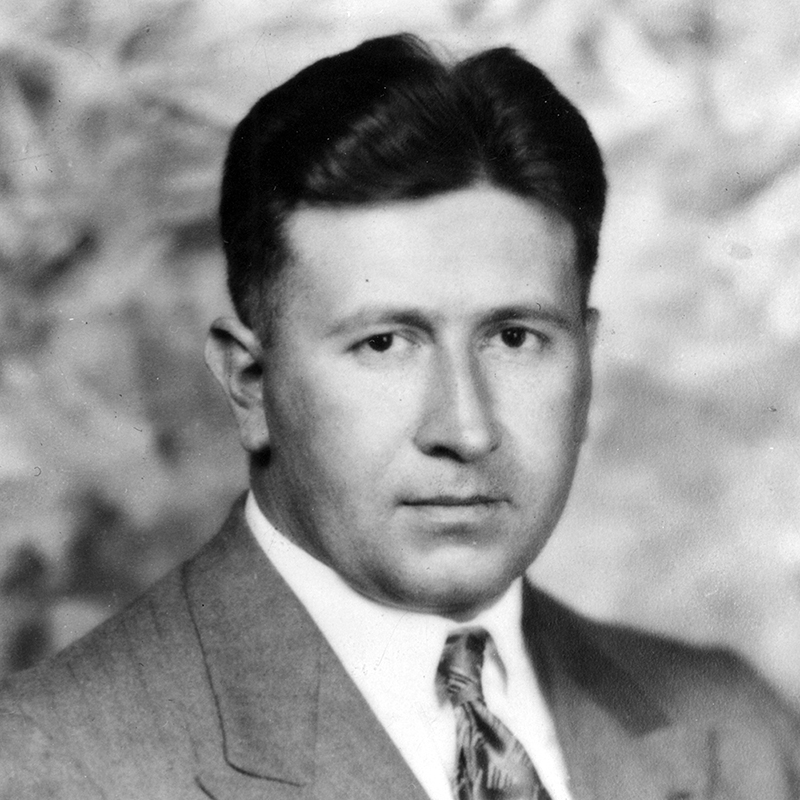
Dr. Harance Troop
1924-1952

Dr. Ralston Scott
1952-1958
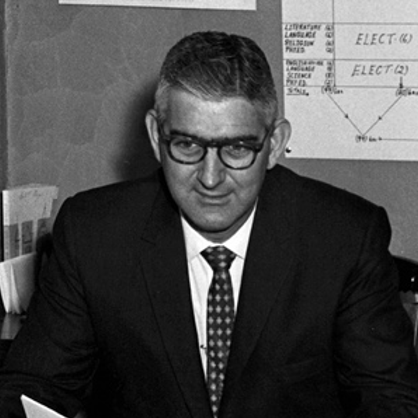
Dr. Bert Glaze
1958-1962

Dr. Stanley Hart
1963-1967
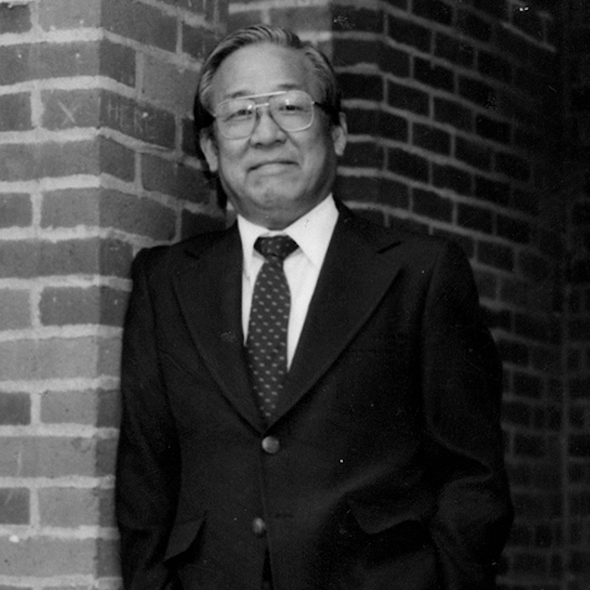
Dr. Young Whe Koo
1969-1989

Dr. Gerald Brown
1990-1994
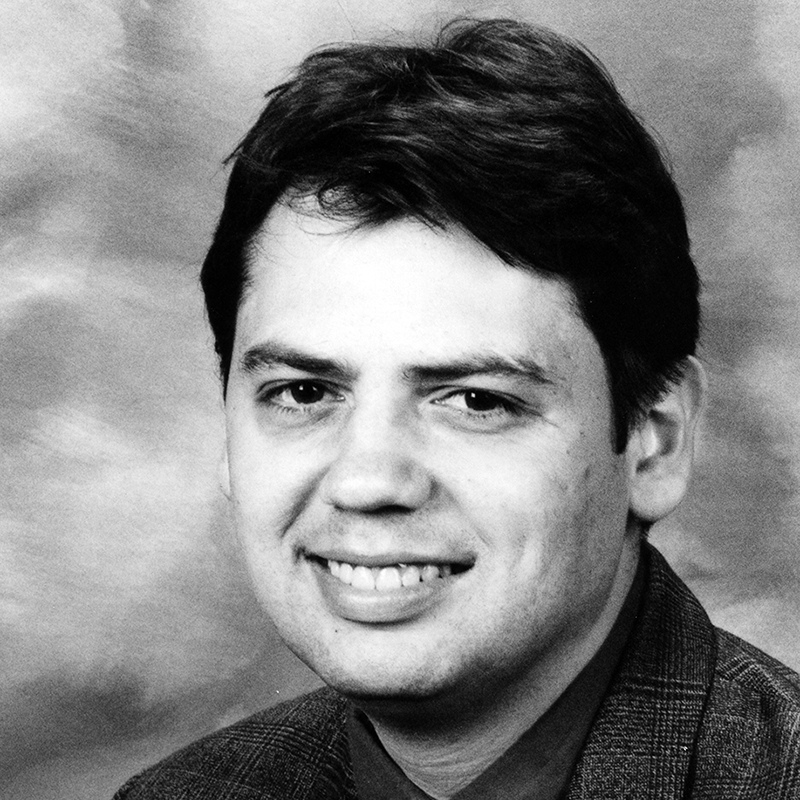
Dr. Kamel Abdullah
1993-1997

Dr. Allen Prindle
1997-2000
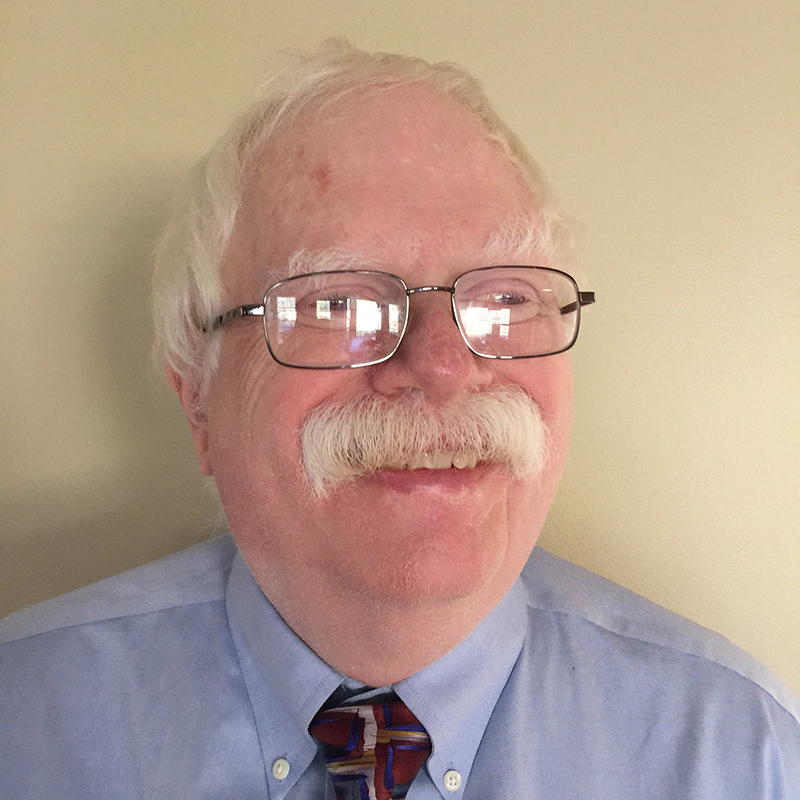
Dr. Charles G. Smith
2000-2008

Dr. Don Eskew
2009-2016, & 2019-2023
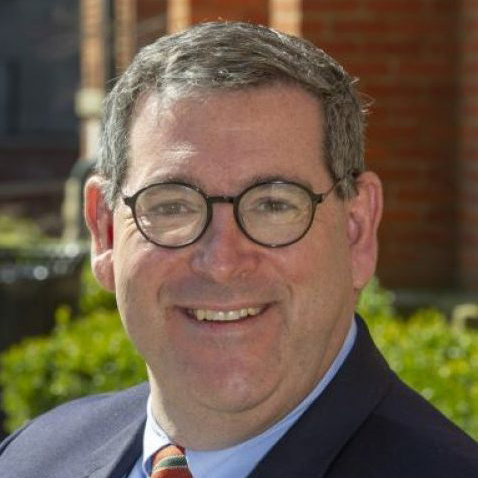
Dr. Michael Levin
2017-2019
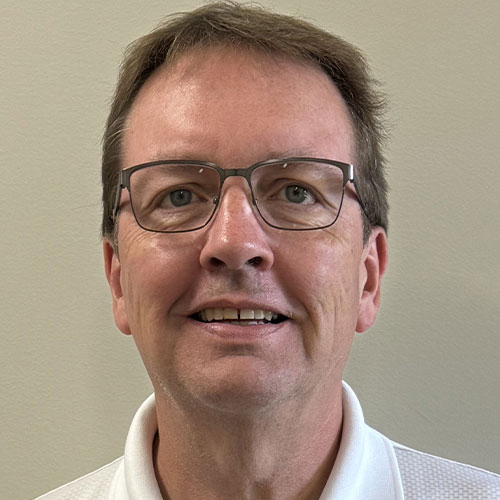
Steve Osborne
2023-current
On this Page:
1924* – 1933
Establishment of the Department of Business Administration
1934 – 1943
Department’s First Name Change: Economics and Business Administration
1944 – 1953
Departmental Growth: Integrating Business Education
1954 – 1963
Evolution of Curriculum: The Shift Toward a Mathematics Focus
1964 – 1973
Pioneering Curriculum Revisions: A New Statistics Lab and More Calculating Machines
1974 – 1983
Preparing Students for Academic and Professional Success
1984 – 1993
The Boom Years: Officially, We Are Called the Department of Business, Accounting, & Economics (BAE)
1994 – 2003
Roush Hall: A New Era for the BAE Department and Otterbein’s Academic Landscape
2004 – 2013
Evolving Excellence: Enhancing Education for Future Business Leaders
2014 – Today
Innovating for the Future: Advancements in Business Education at BAE
1924* – 1933
Establishment of the Department of Business Administration
Our esteemed Department of Business, Accounting, & Economics (BAE) has a rich history. Notably, the first mention of a business-related department was in 1864, but it wasn’t until 1924 that the trustees approved its establishment. It was called the Department of Business Administration. Professor Horace W. Troop led the department, which grew rapidly.
The department has evolved significantly since 1930, transitioning from a one-man department primarily focused on business administration to a four-member department with a greater emphasis on economics.
HORACE W. TROOP
The First Department Chair, Professor of Economics and Business Administration
A.B. Otterbein, 123; A.M. Ohio State University, 1926. Memberships: Pi Kappa Delta; American Economics Association.
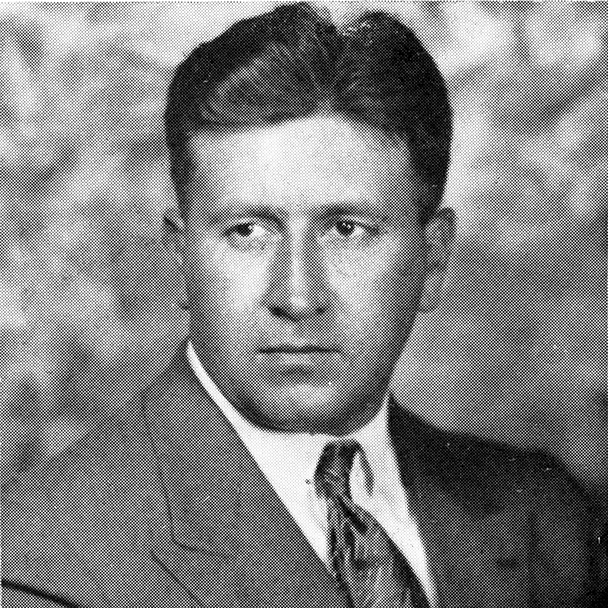

RAYMOND V. PHELAN
Professor of Economics and Business Administration (1926)
Ph.b. (Latin-Scientific) Western Reserve, 1904; A.M. Western Reserve, 1905; Ph.D. University of Wisconsin, 1907. Memberships: Amicaro; Acacia; Skylight: Pi Gamma Mu; Scottish Rite; American Economic Association; American Statistical Association; American Association for Labor Legislation.
“Live a life of Truest breath,
And teach true life to fight
With mortal wrongs.”
1934 – 1943
Department’s First Name Change: Economics and Business Administration
Professor Horace W. Troop, who served as the chair from 1924 to 1952, played a pivotal role in the department’s development for almost three decades. Under his leadership, the department’s name was changed in 1938 to the Department of Economics and Business Administration, reflecting its broader scope. The number of economics courses was increased in the 1940s.
“Professor Horace Troop has been the only member of the department with long tenure. For many years he taught by himself practically all courses in economics, business administration, and political science. He also served as the treasurer of the college in 1941-42 and again from 1946 to 1950. Until 1952 he taught courses on a part-time basis in business law and government at 7:30 A.M. In the classroom he could cite practical illustrations from his own experiences in law, business, politics, and government service. He influenced hundreds of young men in selecting careers in these areas. In 1962 the college awarded him the honorary degree of LL.D.”
The History of Otterbein College, 1930-1972, by Harold b. Hancock
Dr. Troop also served as chairman of Westerville City Council from 1924-1936; president of Westerville School Board, 1942-1950, served three terms as member of the Ohio House of Representatives, 1951-1956; and Judge of Municipal Court, Columbus, 1957-1963. He was also the founder of Westerville law firm and served as the mayor of Westerville for years. With extensive teaching experience, he left a lasting impact on students’ career choices. His contributions were recognized with an honorary degree and the Distinguished Alumnus Award.
1944 – 1953
Departmental Growth: Integrating Business Education
As the department continued growing, it also integrated with business education courses for ten years, named after the Department of Economics, Business Administration, and Business Education (1952-1961).
Under the chairmanship of Dr. Ralston D. Scott from 1952 to 1958, courses were added in typing, shorthand, and commercial subjects, and it became possible to major or minor in business education. According to Otterbein Sybil (1953), nine out of forty-six graduating seniors from Professional Studies majored in business administration.
 Dr. Ralston Scott, Professor of Economics and Business Administration (chair 1952-1958)
Dr. Ralston Scott, Professor of Economics and Business Administration (chair 1952-1958)
Additional Resources:
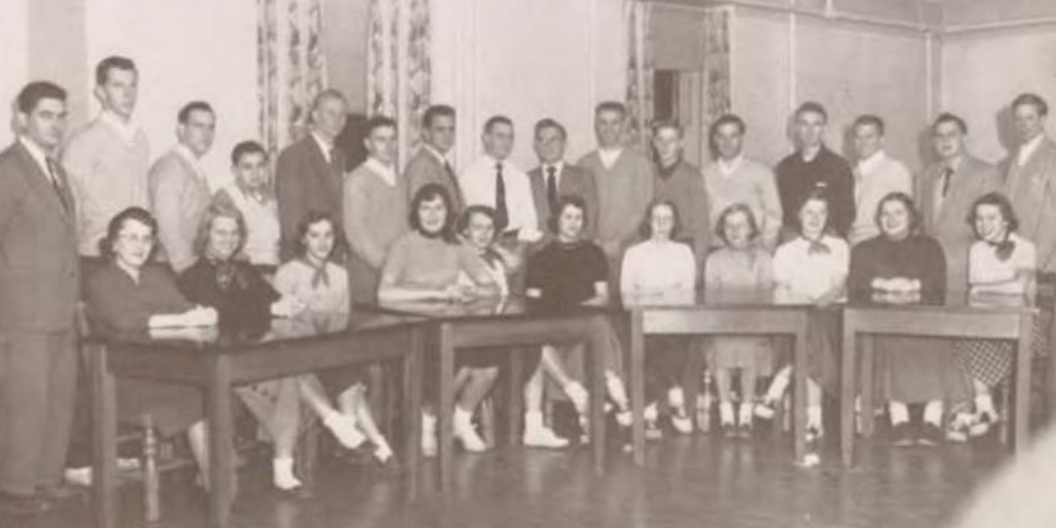 Business Club meeting 1953
Business Club meeting 1953
 Business Club meeting 1954
Business Club meeting 1954
This decade saw a growth in the number of faculty members serving the department.
 Assistant Professor of Economics, James A. Brunner (1847-51)
Assistant Professor of Economics, James A. Brunner (1847-51)
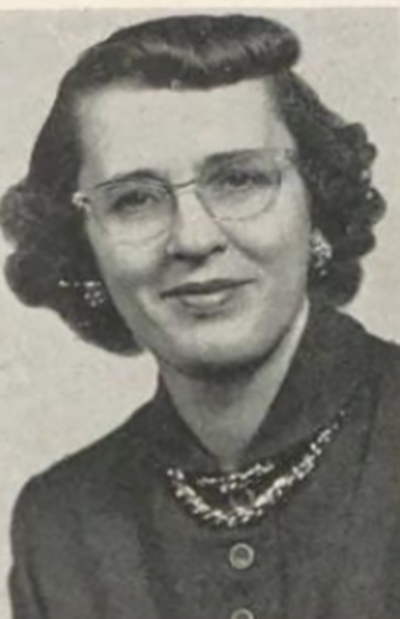 Instructors Miss Marjorie Crossley (1951-55)
Instructors Miss Marjorie Crossley (1951-55)
 Mr. George Hogue, MBA, ‘47
Mr. George Hogue, MBA, ‘47
 Mr. Paul Cone, CPA (1949-51)
Mr. Paul Cone, CPA (1949-51)
1954 – 1963
Evolution of Curriculum: The Shift Toward a Mathematics Focus
The Department of Economics, Business Administration, and Business Education continued bringing innovation and pioneering programs to the community. In 1957, core courses in business law, marketing, accounting, and management were classified under business administration. Courses such as securities and investment were then added in the finance area.
The department’s integration of business education (1951-1961) ended in 1961 to align with the college’s commitment to liberal arts education. Business education courses took a backseat. The department’s focus shifted toward economics and mathematics.
Dr. Bert Glaze, during his tenure from 1958 to 1962, adjusted the curriculum, reducing business administration hours and emphasizing economics. This trend was continued by Dr. Stanley Hart (1963-1967) and Dr. Young Koo (1963-89), who emphasized the importance of economics and mathematics in majors.
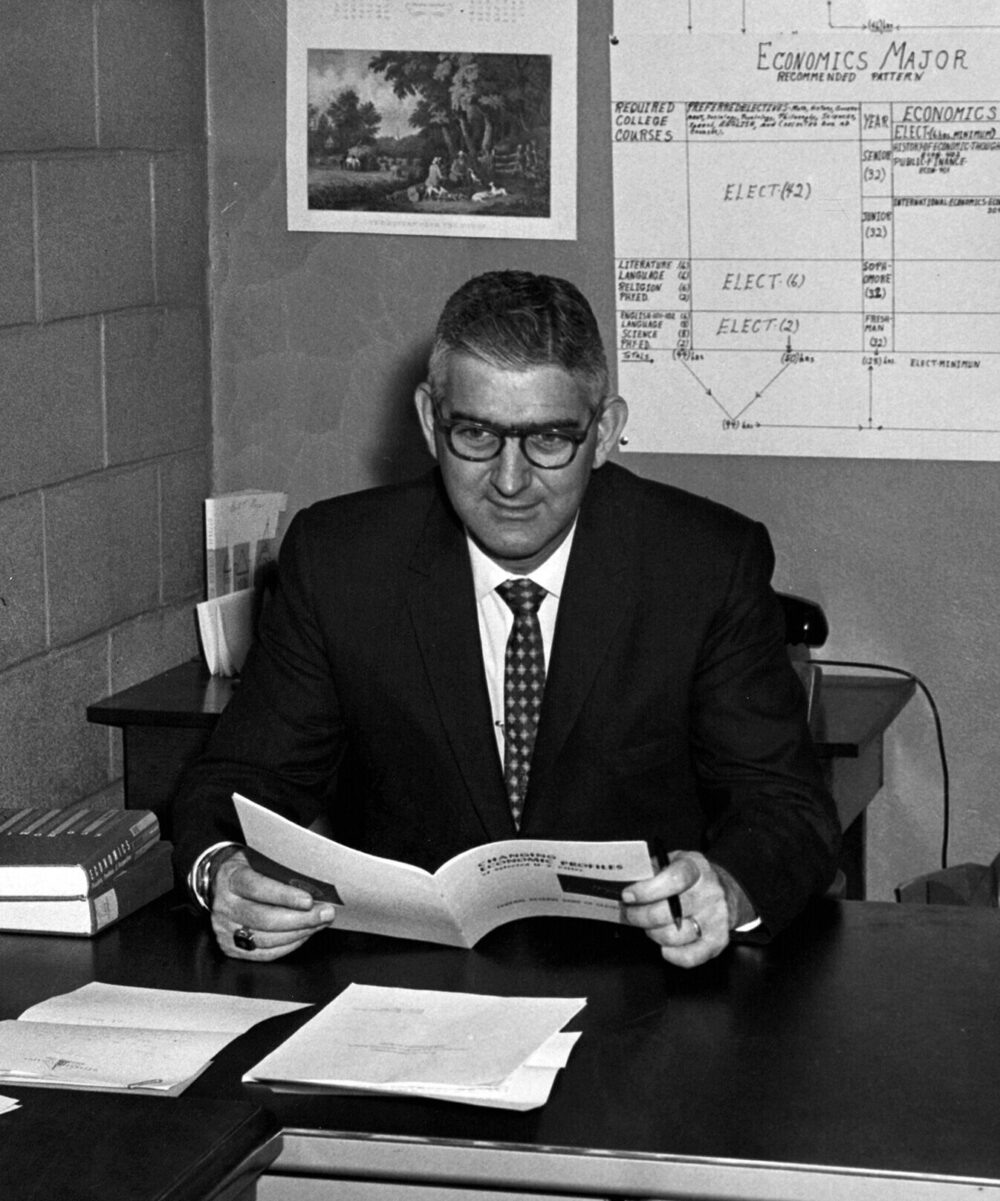 Dr. Bert Glaze, Professor of Economics and Business Administration (chair 1952-1958)
Dr. Bert Glaze, Professor of Economics and Business Administration (chair 1952-1958)
 Business Faculty Members: Hobart Adams, George Hogue, Bert Glaze, Faye Smith (1961)
Business Faculty Members: Hobart Adams, George Hogue, Bert Glaze, Faye Smith (1961)
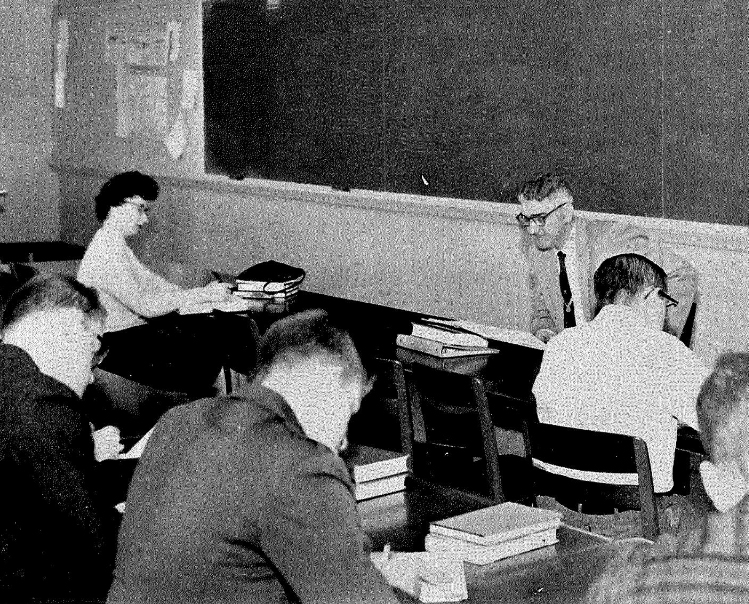
Economics and Business
Headed by Mr. Bert Glaze, the Department of Economics and Business seeks to develop in its students a through understanding of our economic system and to provide basic training in business administration. Today’s business world has become so intricate and close to our lives that a knowledge of economics is valuable to any student regardless of his major. The society for the Advancement of Management is sponsored by this department.
Business and Mathematics
An important department in the Division of Social Studies is that of Economics, business Administration and Business Education. This department is increasingly popular because of the constant demand for college-trained people with a technical background for governmental and industrial positions. Three majors and three minors are offered, giving students an excellent opportunity for a very practical education. Business Education was added to the department in 1951, and six students are now perparing for education degrees in business, while eighteen more are enrolled in the two-year A. G. E. program.
The Department of Mathematics is headed by Dr. Fred Bamforth. Many courses in mathematics are offered . Since every field, in one way or another, utilizes mathematics, it is one department with which nearly all students come into contact.
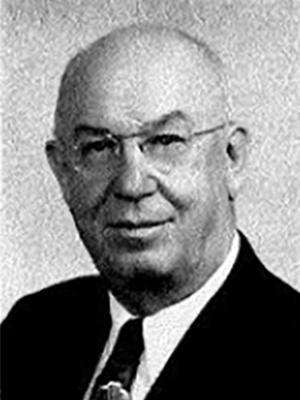 W. Bailey, B.S.
W. Bailey, B.S.
 F. Bamforth, Ph.D.
F. Bamforth, Ph.D.
 R. Scott, Ph.D.
R. Scott, Ph.D.
 F.Smith, M.A.
F.Smith, M.A.
Collaboration Between Business and Mathematics Traced Back to 1955
In 1957, a new business student organization on campus was established – Society for Advancement of Management (S.A.M.). At the meeting, business people, such as personnel directors, salesmen, and administrators, are brought in to give a first-hand account of the activities of the business world. Over years, S.A.M., this national, professional student organization of management in industry, commerce, government, and education on the Otterbein campus strongly supported extracurricular activities. Opportunities such as participation in panel discussions involving the organizing, planning, controlling, and directing of business actions, industry plant tours, business films, and social gatherings.
Society for Advancement of Management (S.A.M.) (1958)
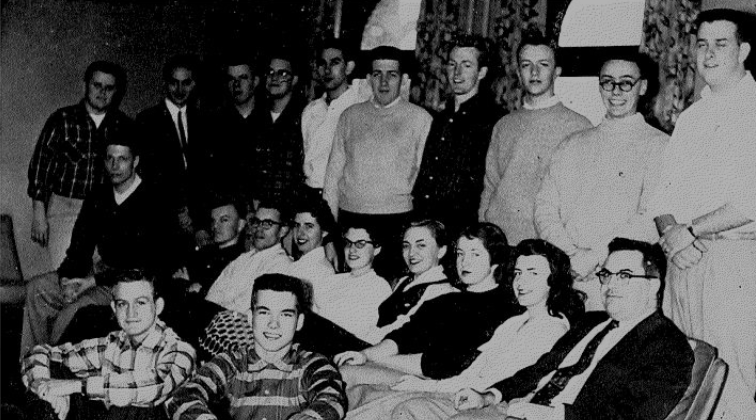 Row 1, Left to right: Dick Drieseidel, Dave cox. Row 2: Dave Dietzel, Dave Arledge, Fred Smith, Carole Carles, Carole Main, Barb Noble, Barbara Cox, Edith Walters, Prof. Hobart Adams. Row 3: Dean Moore, Tom Wetzel, Dave Tobias, Tom Sickle, Jack Coate, George Brown, Jim )'Connor, Jerry Greene, Lee Snyder, Dave Sites
Row 1, Left to right: Dick Drieseidel, Dave cox. Row 2: Dave Dietzel, Dave Arledge, Fred Smith, Carole Carles, Carole Main, Barb Noble, Barbara Cox, Edith Walters, Prof. Hobart Adams. Row 3: Dean Moore, Tom Wetzel, Dave Tobias, Tom Sickle, Jack Coate, George Brown, Jim )'Connor, Jerry Greene, Lee Snyder, Dave Sites
Society for Advancement of Management (S.A.M.) (1960)
 Row 1: J. Spring, D. Rufener, M Weaver, J. Moore. Row 2: S Sidow, Mr. Hogue (standing), J. Reichard, B. Durham, B. Werner, A. Hall. Row 3: B. Martin, A. Duran, B. Swan, R. Richardson.
Row 1: J. Spring, D. Rufener, M Weaver, J. Moore. Row 2: S Sidow, Mr. Hogue (standing), J. Reichard, B. Durham, B. Werner, A. Hall. Row 3: B. Martin, A. Duran, B. Swan, R. Richardson.
1964 – 1973
Pioneering Curriculum Revisions: A New Statistics Lab and More Calculating Machines
The department has pioneered among liberal arts colleges in revising the curriculum with more mathematics skills. A statistics laboratory was established in 1965 and ten calculating machines were purchased. The department continues to operate this laboratory on an interdisciplinary basis. Courses were revised again in 1968, and a one-term introductory course in economics for non-majors was offered as a common course. In 1972, approximately one-third of majors focused on economics, one-third on business administration, and one-third on applied mathematics in business. Additionally, around one-third of all graduating seniors went on to attend graduate school.
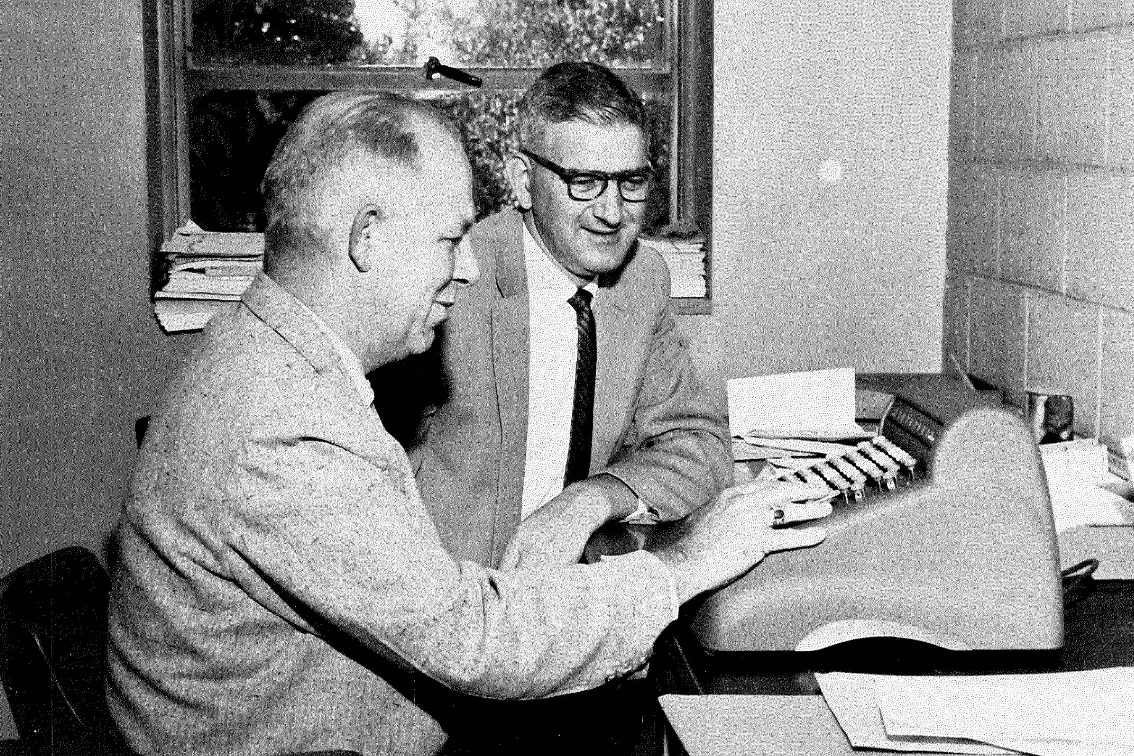 Dr. Glaze watches Mr. Hogue working on the calculating machine
Dr. Glaze watches Mr. Hogue working on the calculating machine
 Business instructor Mr. Miles was advising student (1960-66)
Business instructor Mr. Miles was advising student (1960-66)
“In 1969, there were about 250 students enrolled in the business department.”
The Society for the Advancement of Management 1965

First Row: Joe Laubie, Mark Rone, Rich Hamilton, Tim Merrick, Sam Wolfe, Dow Ruch. Row 2: Dr Hart, Bob Richenbauch, Bert Fields, Allen Hicks, Jim Curfman, John Rushk, James Dupont, Grant Neely.
The Society for the Advancement of Management 1969

Row 1: Jean Shaw, Tom Burak, Morrie Maple, Maggi McClain. Row 2: Chris Bower, Dan Guyton, John Mallett, Ron Simpson, George Martin.
The department’s achievements and curriculum innovations would not have been possible without the support of the faculty members serving during this decade.
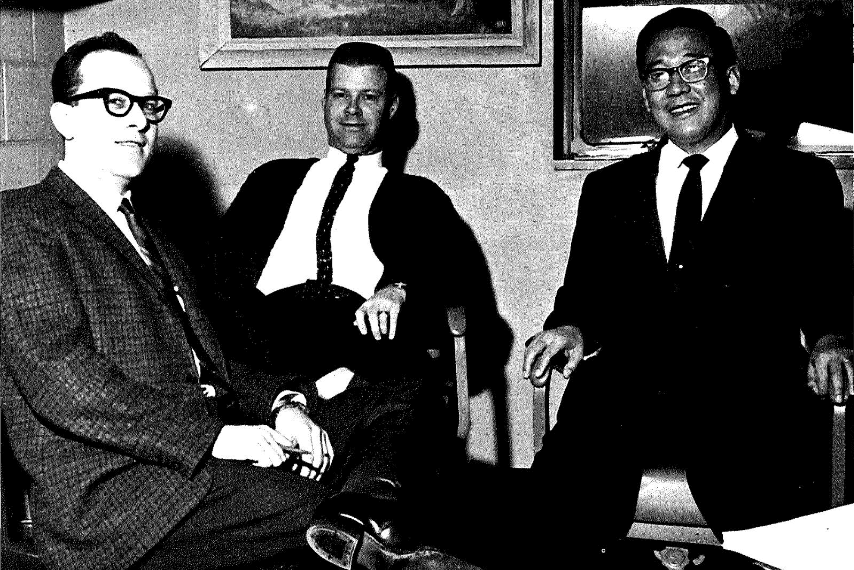
A snapshot of faculty members, Joe Miles, Stanley Hart, Young Whe Koo (1965)

Professor Melencio Cua (1966-74)
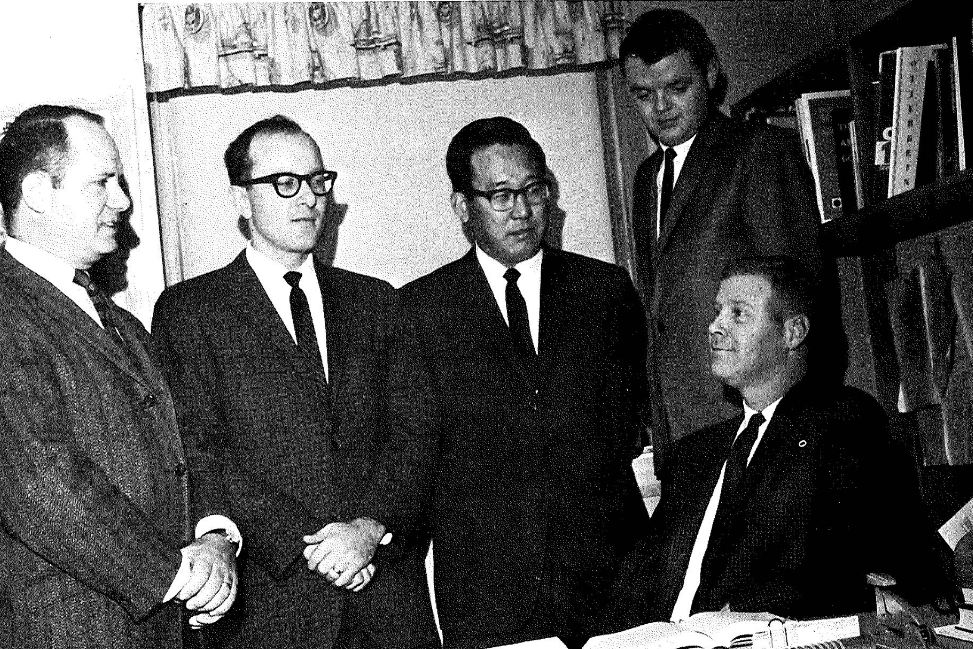
A snapshot of faculty members, Melvin Levine, Joe Miles, Young Whe Koo, John Ezzell, Stanley Hart (1966)
Professor Horace Troop’s daughter and son graduated from Otterbein University. Martha Troop graduated from Otterbein in 1949, and H. William Troop graduated from Otterbein in 1950. Towers Magazine 1969 indicated that H. William Troop ’50 collaborated with two other members and provided a six-month training course in Principles and Practices of Financial Institutions. The special course, originated by Mr. Troop, prepared the young people for jobs in financial institutions after graduation. An important by-product of the course is a knowledge of the principles of money management, often non-existent in the inner-city environment.

1974 – 1983
Preparing Students for Academic and Professional Success
Preparing students for undertaking further studies in graduate schools or for coming high caliber candidates for competitive employment in industry and business is the main goal of the Department in this decade. Statistics in 1970s showed that almost 60% of department majors entered graduate school and performed well. The shortage of graduates to meet demands of industry made this an exceptionally practical and remunerative field.
 BAE faculty members: Harold Hancock, Young Koo, Paul Jursa, Melencio Cua, John Ward (1974)
BAE faculty members: Harold Hancock, Young Koo, Paul Jursa, Melencio Cua, John Ward (1974)
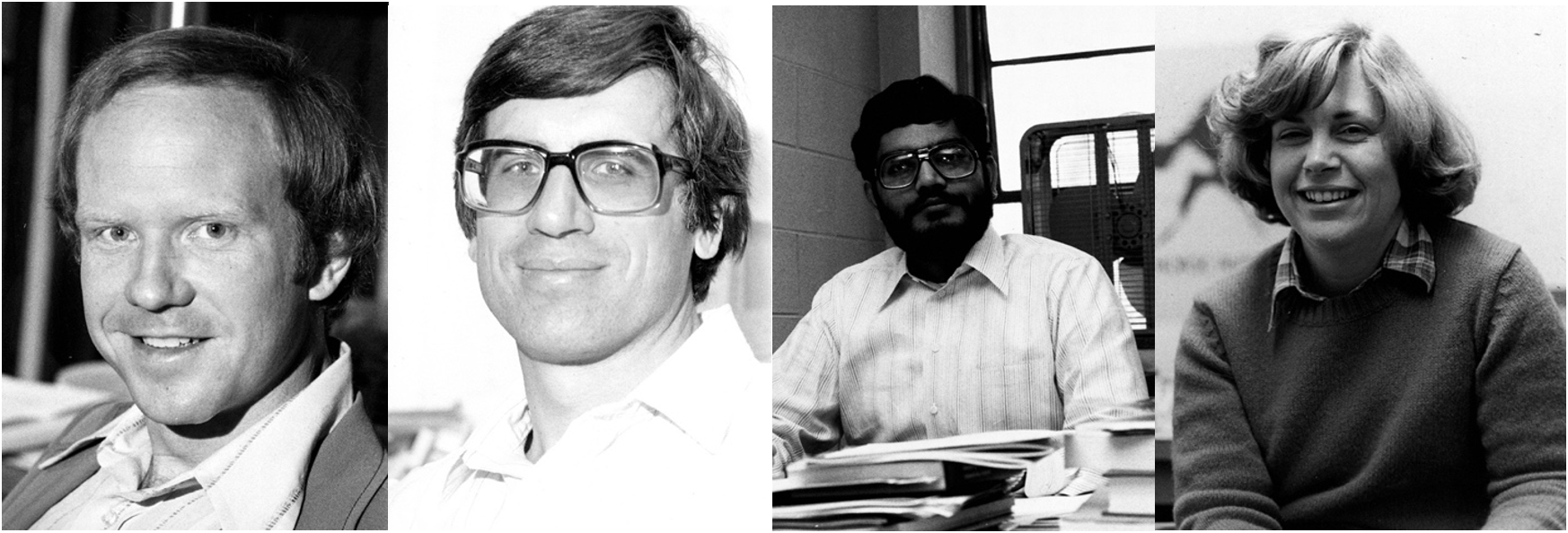 BAE faculty members: Cunningham Donald, Miller Gail, Savishi Vinod, Martha O’Loughlin (1977-1979)
BAE faculty members: Cunningham Donald, Miller Gail, Savishi Vinod, Martha O’Loughlin (1977-1979)
 Professor J. Patrick Lewis (1977)
Professor J. Patrick Lewis (1977)
Professor J. Patrick Lewis started his career as an economics professor at Otterbein after earning Ph.D. in Economics from Ohio State University. He initially focused on academic research and teaching at Otterbein. However, his passion for writing led him down a different path—he eventually shifted from the analytical world of economics to the imaginative world of children’s poetry and literature. His sense of humor shines through in his joke about needing “a very delicate operation” to shift from economics to children’s poetry (Poetry Foundation). Over time, J. Patrick Lewis has published over 50 children’s books, many of which are celebrated for their playful, educational themes and poetic storytelling (National Endowment for the Arts).
 J. Patrick Lewis and his books (National Endowment for the Arts, 2012)
J. Patrick Lewis and his books (National Endowment for the Arts, 2012)
1984 – 1993
The Boom Years: Officially, We Are Called the Department of Business, Accounting, & Economics (BAE)
The department became one of the largest departments on campus in the 1980s. It continued its excellence in preparing students interested in business and economics for the job market. The department is constantly growing and expanding to meet the requirements of the rapidly growing business world. A new major in business/organization communication was added in 1985.
In the 1980s, the department faculty members included Gail Miller, Donald Cunningham, James Heine, Laurence Kantor, Martha O’Loughlin, and Young Koo.
The Department of Business and Economics was continually growing. A new major was introduced this year – business organization communication, which was a joint venture of the business, English, and speech communication departments. Business remained one of the most popular majors at Otterbein. with Otterbein’s co-op program, students had the chance to gain experience in all types of occupations.
Starting in 1987, Tau Pi Phi, Otterbein’s business honorary, consists of students who have taken 20 hours of business administration, economics, or accounting courses, and who hold a 3.0 cumulative and business major GPA. Dr. Richard Heffelfinger served as the faculty advisor for this honor group, which was one of 16 chapters nationwide at schools of similar size.
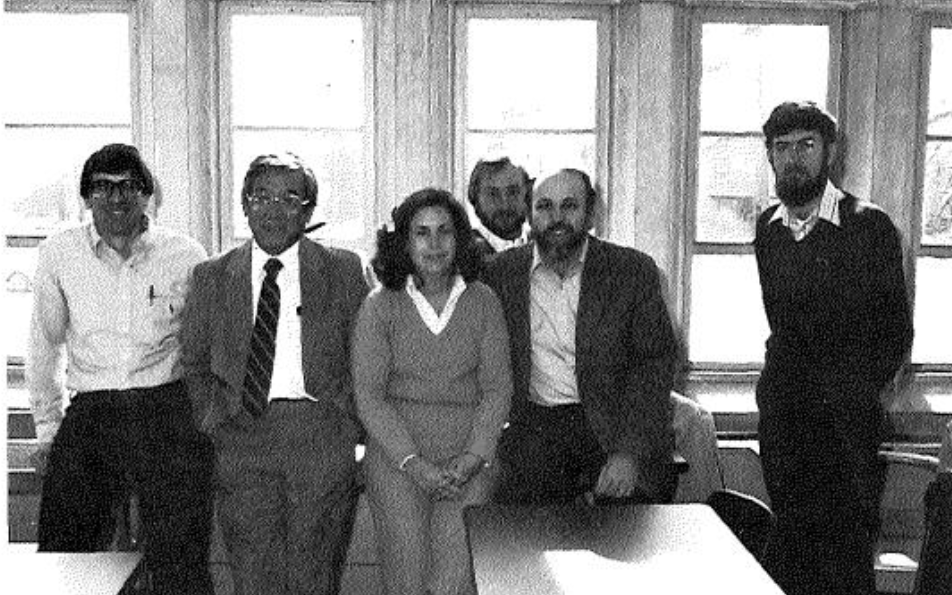 Seven department faculty members include Gail Miller, Young Koo, Martha O'Loughlin, Wallace Davidson, Patrick Lewis, John Glascock, James Heine (not pictured)
Seven department faculty members include Gail Miller, Young Koo, Martha O'Loughlin, Wallace Davidson, Patrick Lewis, John Glascock, James Heine (not pictured)
In 1990, the department was renamed as the Department of Business, Accounting & Economics, which is well known as BAE nowadays! Otterbein entered the new decade to upgrade academics and approved its revised curriculum in BAE, requiring students 85 quarter-hours of coursework in their major in business administration or accounting, compared to 70. An economics major required 75 hours, up from 55. As part of curriculum revision, all business, accounting, and economics majors must take both a speech and a technical writing class, compared to one class from the two. In the same year, the department welcomed a new member in Economics, Dr. Allen Prindle.
In 1990, over 460 students were enrolled as business administration majors, the most popular major at Otterbein. There was an increase of 65% from four years ago, when there were 282 business majors.
A closer look at three BAE faculty members in 1990
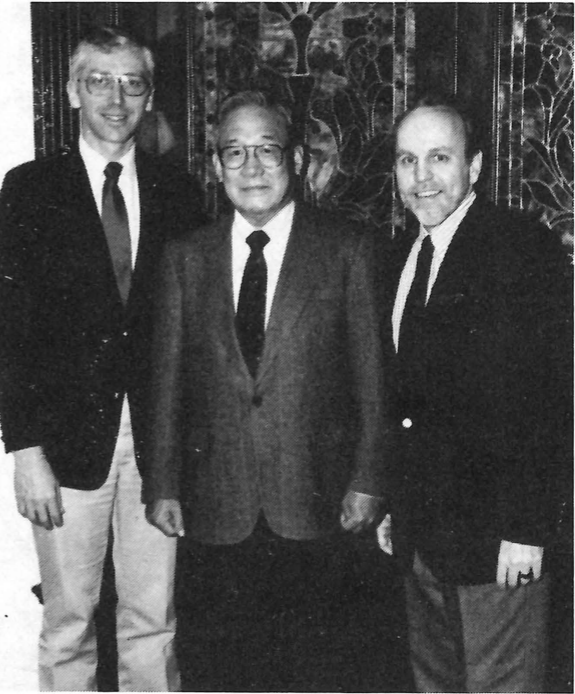
From Left: Prindle, Koo, and Lewis (Photo by David Henn).
The newest member of the economics faculty, assistant professor Allen Prindle joined the department full-time in 1989. He is an alumnus of the University of Wisconsin, River Falls, and earned a master’s degree from Purdue University and Ph.D. from Penn state University.
He and his wife, Nancy, currently make their home near Radnor, Ohio. They have two children.
Professor J. Patrick Lewis graduated from St. Joseph’s College and earned his master’s degree at Indiana University before receiving his Ph.D. at The Ohio State University.
He has been with Otterbein since 1974. A native of Gary, Ind., he now makes his home in Westerville.
He is the father of three children. Lewis’ writing has been published extensively everything from short stories, poetry and economics reviews to the successful children’s book, The Tsar and the Amazing Cow, which received critical acclaim in the New York Times.
Young Koo, professor and former business and economics department chair for 15 years, has been with the College since 1963. A native of Seoul, Korea, he graduated from the university Of Georgia, earned a master’s degree at the University of Alabama and Ph.D. from the Ohio State University. Koo has done much consulting work in the United States, acting as an area specialist of Far Eastern Trade. He and his wife, Chung reside in Westerville. They have two children.
1994 – 2003
Roush Hall: A New Era for the BAE Department and Otterbein’s Academic Landscape
Roush Hall was open! The Edwin L. and Mary Louise Roush Hall, the first building erected solely for academics since 1872, was dedicated on the morning of June 12, 1993. Roush Hall has been housing the Business, Accounting and Economics, and Education departments, besides providing multi-purpose classrooms, conference rooms, and computer labs.
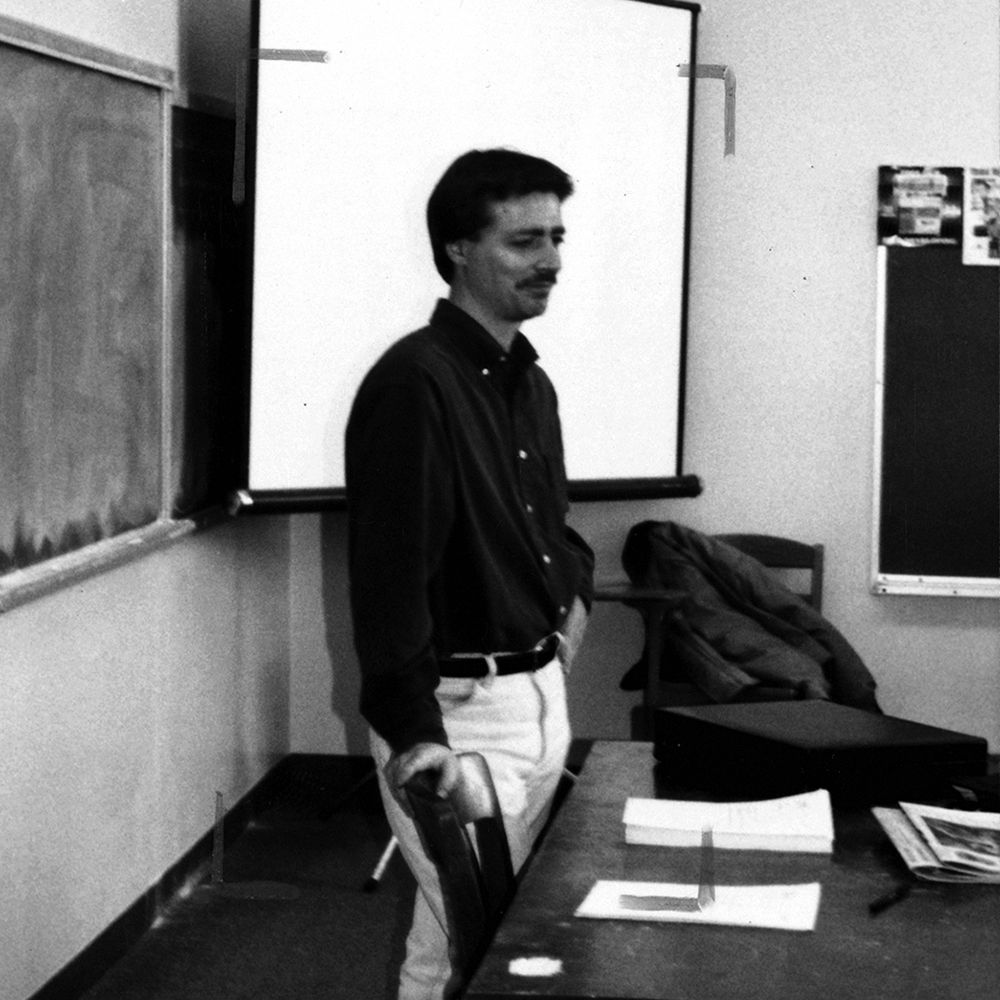 Dr. Don Eskew’s very first class at Otterbein BAE (1994)
Dr. Don Eskew’s very first class at Otterbein BAE (1994)
While the brand-new Roush Hall added a change of scenery for students and a more modern aspect of the Otterbein tradition, the Department of Business, Accounting, and Economics (BAE) was managed by a group of committed faculty members and directors to meet the growing demand of students and the ever-changing business world. In addition, the MBA program earned accreditation in 1998. In the late 1990s and early 2000s, the department has the largest group of faculty members (14), including Kamel Abdallah, Gail Arch, Allen Prindle, J. Patrick Lewis, Kyriacos Aristotelous, David Dennis, Don Eskew, Richard Heffelfinger, Marsha Huber, David Jones, Shirine Mafi, Donna Marple, Bruce Bailey, and Terry Wallenbrock.
Otterbein’s Continuing Studies program offered many different majors for adults. Business administration was also one of the most popular programs and our faculty supported the Continuing Studies programs in many ways, such as offering evening and weekend courses and courses.
 BAE faculty members 2000: Kamel Abdullah, Arburn Gregory, Gail Arch, Bruce Bailey, David Jones
BAE faculty members 2000: Kamel Abdullah, Arburn Gregory, Gail Arch, Bruce Bailey, David Jones
2004 – 2013
Evolving Excellence: Enhancing Education for Future Business Leaders
The Department has undergone significant evolution to better serve its students and the changing dynamics of the business world. A notable shift has been the transition from a quarter system to a semester system, enabling deeper engagement with course materials and fostering a more aligned academic rhythm with other institutions. This change has streamlined academic processes, allowing students and faculty to maximize learning outcomes over a longer period, enhancing the overall educational experience.
In addition, the department has restructured its academic offerings, moving from broad concentrations in business to a more refined system of majors and minors across all business disciplines, including majors in accounting, business administration, economics, international business, finance, management, and marketing. This shift offers students the flexibility to specialize in their areas of interest while providing a solid foundational knowledge of core business principles. It allows for tailored educational paths that meet the diverse needs of students, preparing them for varied roles in the business sector.
In 2009, the department launched a new business course for non-business majors, to create a more well-rounded educational experience and prepare students for the business side of non-business careers. This new course – Business Essentials – was designed to provide undergraduate non-business majors an overview of the essential functions of business operations. The course topics included introductions to accounting, finance, economics, business planning, human resources, strategy, marketing, international business, and management. After completion of this course, non-business majors will have a better understanding of the basic rudiments of business and the general components that impact business decision-making.
Notably, Dr. Shirine Mafi, a professor in management has integrated philanthropy in the BAE department with courses, student clubs, and student engagement since the 2000s. She emphasized that the task in higher education is to reflect on our teaching to see how we can train future leaders to be more socially responsible, not only moral but also essential. Dr. Shirine Mafi integrated philanthropy in her management course since 2000.

2014 – Today
Innovating for the Future: Advancements in Business Education at BAE
In the past ten years to today, The Department of Business, Accounting, and Economics (BAE) has made significant strides in enhancing its academic offerings and overall educational experience. A major development was the transition from a four-credit to a three-credit model, which streamlined the curriculum and allowed students to take a wider variety of major courses and to consider a double major in business or non-business discipline. This change not only provided more flexibility but also enabled students to delve deeper into their areas of interest.
In addition to updating its Bachelor of Science degrees, Dr. Michael Levin and Dr. Ava Liu collaborated with computer science and math programs, and led the work to launch a Business Analytics degree, reflecting the growing importance of data-driven decision-making in the business world. This focus on analytics ensures that graduates are well-equipped with the skills necessary for success in an increasingly data-centric landscape.
Experiential learning is a cornerstone of the department’s mission, with opportunities for students to engage in extracurricular activities such as international competitions. These competitions provide real-world experience, allowing students to apply their knowledge in practical settings while enhancing their teamwork and leadership skills.
Today, the BAE department remains a cornerstone of Otterbein’s academic landscape The department offers a flexible core curriculum for both majors and minors, emphasizing critical thinking, problem-solving, and decision-making skills. It is committed to experiential learning, providing students with practical insights through classroom projects, international competitions, and internships with prominent companies such as Nationwide, JPMorgan Chase, and KPMG. Committed to its legacy of innovation and academic rigor, it continues to shape the future of business education and nurture the next generation of entrepreneurs and business professionals as it enters its second century.
Sources: Education for Humanity, The story of Otterbein College, by Willard W. Bartlett, 1934; The History of Otterbein College 1930-1972, by Harold B. Hancock, 1972; University Archives, Otterbein BAE department, Otterbein Sibyl yearbooks, Towers magazines
Note: This retrospective celebrates 100 years of the department’s history, highlighting its development, curriculum revisions, student organizations, and faculty contributions. For further reference, the Otterbein Sibyl yearbooks and Towers magazine offer numerous stories of alumni. Please note that some distinguished members and alumni may not be included due to the limited materials reviewed. If you would like to provide updates or share additional history, please feel free to reach out to Dr. Ava Liu via email at yliu1@otterbein.edu.

